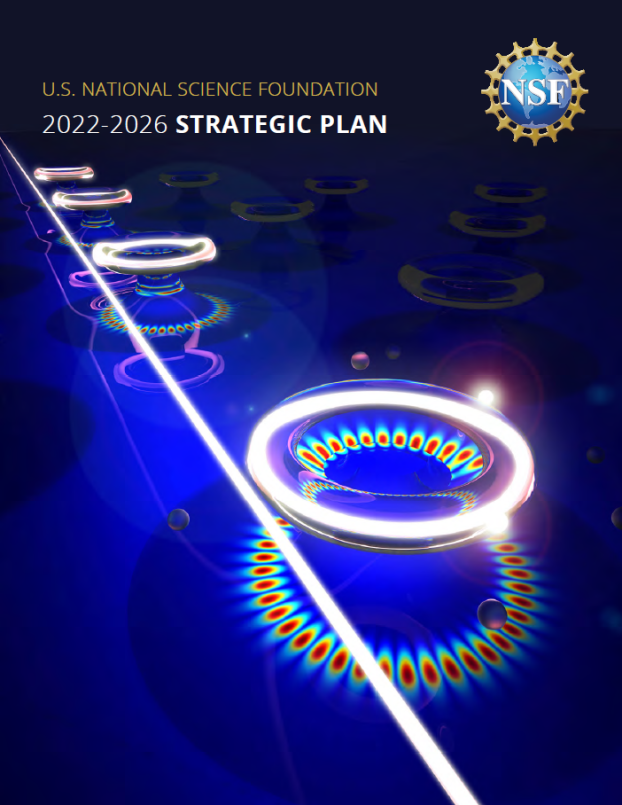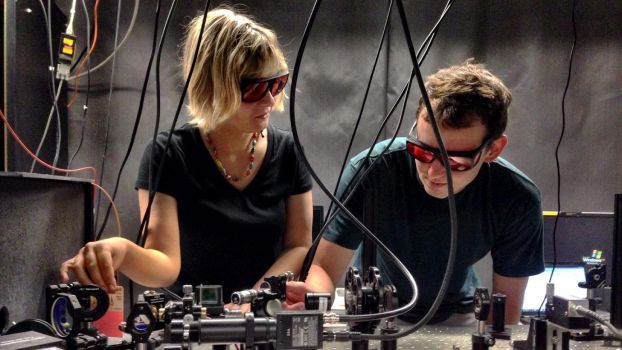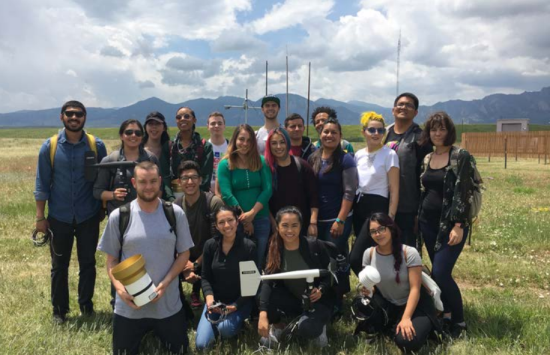
The NSF vision: A nation that leads the world in science and engineering research and innovation, to the benefit of all, without barriers to participation.
The NSF mission: NSF promotes the progress of science by investing in research to expand knowledge in science, engineering and education. NSF also invests in actions that increase the capacity of the U.S. to conduct and exploit such research.
To promote the progress of science; to advance the national health, prosperity and welfare; and to secure the national defense.
NSF's core values: NSF's core values are essential and enduring tenets that guide everyone in the organization as we support the agency's mission. They have been developed with the active engagement of NSF staff. These values identify who we are and what is important to us. They guide how we make decisions, set priorities, address challenges, manage trade-offs, recruit and develop personnel and work together with our awardees.
- Scientific leadership.
- Diversity and inclusion.
- Integrity and excellence.
- Public service.
- Innovation and collaboration.
 Explore NSF's Strategic Goals and Objectives
Explore NSF's Strategic Goals and Objectives
Strategic Goal 1 — Empower
Empower STEM talent to fully participate in science and engineering.
S&E are key to the nation's economic progress, and people are the core of America's scientific progress. To accelerate the advancement of discovery and learning, prepare for a world in which work is increasingly reliant upon scientific and technological skills and ensure that all citizens share in the benefits that flow from research, we must promote inclusion in the research community and STEM workforce, access to STEM learning and training and widespread STEM literacy.
Our global competitiveness depends critically on the readiness of the nation's STEM workforce, but millions of talented individuals are missing from that workforce. NSF seeks to empower these missing millions15 by making strategic investments in researchers and research training to harness the talents and creativity of America's diverse population. NSF also supports research into practical ways to promote a scientifically literate U.S. population that is well prepared for the economy and challenges of the 21st century.
NSF also supports research into practical ways to promote a scientifically literate U.S. population that is well prepared for the economy and challenges of the 21st century.
Strategic Objective 1.1 — Ensure accessibility and inclusivity
Increase the involvement of communities underrepresented in STEM and enhance capacity throughout the nation.
Strategic Objective 1.2 — Unleash STEM talent for America
Grow a diverse STEM workforce to advance the progress of science and technology.
Research Experiences for Undergraduates (REU)
NSF funds a large number of research opportunities for undergraduate students thought its REU Sites program. These experiences have inspired many students to pursue careers in research and science. REU Sites make a special effort to recruit from groups underrepresented in science and engineering.
Strategic Goal 2 — Discover
Create new knowledge about our universe, our world and ourselves.
This goal furthers the first part of NSF's mission, "to promote the progress of science," pursuing the generation of new knowledge so the nation remains a global leader in expanding discovery in science, engineering and learning. By generating new knowledge, NSF-funded researchers provide the nation with the capability to maintain scientific, technological and economic leadership in a competitive world.
Fundamental research is a capital investment for the nation. Basic research leads to new knowledge. It provides scientific capital. It creates the fund from which the practical applications of knowledge must be drawn. New products and new processes do not appear full-grown. They are founded on new principles and new conceptions, which in turn are painstakingly developed by research in the purest realms of science. Those practical applications of knowledge sometimes begin to be realized very quickly; for example, some of NSF's investments in research related to the SARS-CoV-2 pandemic produced actionable results within months. In other cases, the practical applications may not be fully felt until decades after the initial basic research. A connection between fluid dynamics and an improved industrial process may be easier to foresee than the practical benefits of fundamental physics research into what Einstein called "spooky action at a distance," but the initial research on quantum mechanics in the early 20th century paved the way for the development of new approaches to secure communications and more powerful computers that is underway in the 21st century's research on quantum information systems.
Just as financial advisors stress the importance of diversifying investments, so the benefits of research are maximized when a wealth of different fields and research questions are supported. NSF embodies this by supporting all fields of basic science, engineering and STEM learning research. NSF welcomes proposals for original research and for new tools, such as advanced instrumentation, data analysis, computation and novel facilities. Investment in competitively selected projects expands the knowledge base from which innovation springs. A special role of NSF is to encourage creative efforts that may not fit within the domain of specific mission agencies.
NSF fosters a culture of "smart risk-taking" and cultivates the spirit of exploration in researchers and students. Reviewers are encouraged to look for high potential rewards that justify taking risks to support projects that may not always work as planned.
NSF provides leadership in an evolving global research enterprise by supporting modern collaborative approaches to science, funding research within and between traditional fields and strengthening interactions between U.S. researchers and their leading counterparts abroad. By using novel funding mechanisms for exploratory research, NSF catalyzes and incubates new fields of research and the search for new insights that disrupt traditional understanding.
Strategic Objective 2.1 — Advance the frontiers of research
Accelerate discovery through strategic investments in ideas, people and infrastructure.
Strategic Objective 2.2 — Enhance research capability
Advance the state of the art in research practice.
Enabling the biotechnology industry
NSF-supported researchers Jennifer Doudna and Emmanuelle Charpentier teamed up to fuse tracr-RNA and CRISPR-RNA to produce what they called guide RNA, a tool that enables cleavage of DNA molecules at extremely precise locations, based on how the guide RNA was designed. This technology continues to transform the way we understand gene regulation.
Strategic Goal 3 — Impact
Benefit society by translating knowledge into solutions.
NSF has since its creation in 1950, impacted society not only in the U.S. but also around the world. From groundbreaking discoveries used for medicine and gene therapies to cybersecurity research that protects individuals, corporations and governments alike, NSF has been at the forefront of scientific discovery and technological advancements improving society for this generation and the next.
Curiosity-driven, discovery-based explorations and use-inspired, solutions-focused innovations are part of NSF's DNA. The scientific pursuit of knowledge and understanding is part of the development of new technological capabilities. And in turn, those new capabilities allow us to pursue new research questions that were either unseen or out of our reach.
For the past 70 years, NSF has made transformative impacts possible through strategic, long-term commitments to advancing the entire spectrum of research, and through partnerships to catalyze new ideas, new discoveries and new technologies.
Decades of investment have positioned the U.S. as the world leader in curiosity-driven research and resulted in breakthroughs in emerging fields from renewable energy to quantum computing and AI. These discoveries have also resulted in translation of research and innovations that have changed the world — from smartphones to 3D printing and much more.
To accelerate translation of knowledge to innovation outcomes requires looking at all the components that make it possible — partnerships, infrastructure, and most importantly, people. NSF advances scientific careers by providing the support needed for researchers to explore bold ideas. For example, NSF has a multitude of programs, fellowships and career awards to strengthen pathways into STEM fields, increase diversity and expand our reach into all communities where talent exists.
By engaging stakeholders outside the research community, research questions whose answers will have a meaningful societal impact can be more readily identified. Such research is strengthened by the active involvement of stakeholders in shaping and facilitating the research, as well as in evaluating intermediate results.
Strategic Objective 3.1 — Deliver benefits from research
Advance research and accelerate innovation that addresses societal challenges.
Strategic Objective 3.2 — Lead globally
Cultivate a global S&E community based on shared values and strategic cooperation.

Jump-starting the Quantum Revolution
NSF's strategic investments in foundational R&D have jump started the quantum revolution. NSF-funded researchers are laying the groundwork for quantum technologies by developing new materials and components. Efforts to develop a viable quantum computer could advance multiple fields including AI, personalized drug development and weather forecasting.
Strategic Goal 4 — Excel
Excel at NSF operations and management.
The first three strategic goals are associated with quickly evolving challenges. Meeting these and effectively fulfilling NSF's mission requires blending strong scientific leadership with robust organizational leadership. Both are characterized by vision and flexibility. NSF will reinforce its capacity to scale rapidly to advance an expanding portfolio that meets the growing need for breakthroughs in research and innovation.
With the rapidly growing importance of exploratory and solutions-focused research for securing economic competitiveness and meeting pressing societal challenges, NSF must expand and strengthen the speed and scale at which research is conducted, research products are delivered and research and innovation communities grow.
Strategic Objective 4.1 — Strengthen at Speed and Scale
Pursue innovative strategies to strengthen and expand the agency's capacity and capabilities.
Strategic Objective 4.2 — Invest in People
Attract, empower and retain a talented and diverse NSF workforce.

United States Antarctic Program
Without interruption since 1956, Americans have been studying the Antarctic and its interactions with the rest of the planet. These investigators and supporting personnel make up the U.S. Antarctic Program. Funded and managed by NSF, the program carries forward the Nation's goals of supporting the Antarctic Treaty, fostering cooperative research with other nations, protecting the Antarctic environment, and developing measures to ensure only quittable and wise use of resources.



